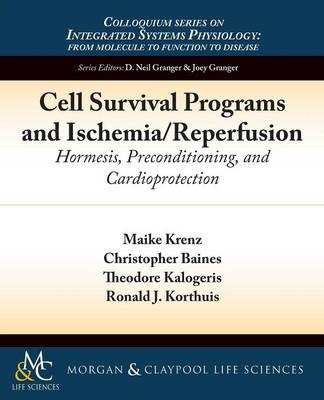
Cell Survival Programs and Ischemia/Reperfusion
Hormesis, Preconditioning, and Cardioprotection
Seiten
2013
Morgan & Claypool Publishers (Verlag)
978-1-61504-584-6 (ISBN)
Morgan & Claypool Publishers (Verlag)
978-1-61504-584-6 (ISBN)
Reviews the evidence supporting the concept that intrinsic cell survival programmes can be activated by a variety of mildly noxious stimuli or pharmacologic agents to confer protection against the deleterious effects of ischemia/reperfusion.
The major purpose of this book is to review the evidence supporting the concept that intrinsic cell survival programs can be activated by a variety of mildly noxious stimuli or pharmacologic agents to confer protection against the deleterious effects of ischemia/reperfusion (I/R). We begin with a discussion of the concept of hormesis (a term used most extensively in the toxicologic literature which refers to biphasic cellular responses that depend on concentration or intensity of a stimulus), review the seminal studies that led to the discovery of the cardioprotective effects of ischemic preconditioning, and outline its therapeutic potential (Chapter 1). This is followed by a summary of our current understanding of the mechanisms of I/R injury (Chapter 2), as this provides several points of intervention in limiting postischemic tissue injury that may be targeted by the adaptive programs invoked by conditioning stimuli. Chapters 3 and 4 focus on the mechanisms underlying ischemic pre-, post-, and remote conditioning, which establishes the mechanistic rationale for development of pharmacologic conditioning strategies that may mimic the remarkably powerful effects of ischemic conditioning (and are covered in Chapter 5). Lifestyle interventions, including exercise, caloric restriction, and consumption of alcoholic beverages and/or phytochemicals, that may induce hormetic responses will also be reviewed in this chapter. While the promise for conditioning as a therapeutic approach is enormous, there are obstacles to its practical application in patients, which are covered in Chapter 6. The final chapter (Chapter 7) examines the extension of our mechanistic understanding of the signaling pathways invoked by conditioning stimuli into the realm of gene therapy and to the preservation of stem cell viability in the harsh ischemic environment as natural translational outgrowths of preconditioning into therapeutics.Table of Contents: Introduction / Hormesis and Preconditioning Defined / Mechanisms of Ischemia/Reperfusion Injury / Ischemic Preconditioning and Cardioprotection / Clinically Useful Applications of Ischemic Conditioning: Distant Site Ischemic Preconditioning and Ischemic Postconditioning / Cardioprotection Induced by Pharmacologic Conditioning and Lifestyle Interventions that Mimic Preconditioning / Cardiovascular Risk Factors, Tachyphylaxis, and the Efficacy of Pre- and Postconditioning / Logical Extensions of Preconditioning: Gene and Stem Cell Therapy for I/R / Acknowledgments / References
The major purpose of this book is to review the evidence supporting the concept that intrinsic cell survival programs can be activated by a variety of mildly noxious stimuli or pharmacologic agents to confer protection against the deleterious effects of ischemia/reperfusion (I/R). We begin with a discussion of the concept of hormesis (a term used most extensively in the toxicologic literature which refers to biphasic cellular responses that depend on concentration or intensity of a stimulus), review the seminal studies that led to the discovery of the cardioprotective effects of ischemic preconditioning, and outline its therapeutic potential (Chapter 1). This is followed by a summary of our current understanding of the mechanisms of I/R injury (Chapter 2), as this provides several points of intervention in limiting postischemic tissue injury that may be targeted by the adaptive programs invoked by conditioning stimuli. Chapters 3 and 4 focus on the mechanisms underlying ischemic pre-, post-, and remote conditioning, which establishes the mechanistic rationale for development of pharmacologic conditioning strategies that may mimic the remarkably powerful effects of ischemic conditioning (and are covered in Chapter 5). Lifestyle interventions, including exercise, caloric restriction, and consumption of alcoholic beverages and/or phytochemicals, that may induce hormetic responses will also be reviewed in this chapter. While the promise for conditioning as a therapeutic approach is enormous, there are obstacles to its practical application in patients, which are covered in Chapter 6. The final chapter (Chapter 7) examines the extension of our mechanistic understanding of the signaling pathways invoked by conditioning stimuli into the realm of gene therapy and to the preservation of stem cell viability in the harsh ischemic environment as natural translational outgrowths of preconditioning into therapeutics.Table of Contents: Introduction / Hormesis and Preconditioning Defined / Mechanisms of Ischemia/Reperfusion Injury / Ischemic Preconditioning and Cardioprotection / Clinically Useful Applications of Ischemic Conditioning: Distant Site Ischemic Preconditioning and Ischemic Postconditioning / Cardioprotection Induced by Pharmacologic Conditioning and Lifestyle Interventions that Mimic Preconditioning / Cardiovascular Risk Factors, Tachyphylaxis, and the Efficacy of Pre- and Postconditioning / Logical Extensions of Preconditioning: Gene and Stem Cell Therapy for I/R / Acknowledgments / References
Introduction
Hormesis and Preconditioning Defined
Mechanisms of Ischemia/Reperfusion Injury
Ischemic Preconditioning and Cardioprotection
Clinically Useful Applications of Ischemic Conditioning: Distant Site Ischemic Preconditioning and Ischemic Postconditioning
Cardioprotection Induced by Pharmacologic Conditioning and Lifestyle Interventions that Mimic Preconditioning
Cardiovascular Risk Factors, Tachyphylaxis, and the Efficacy of Pre- and Postconditioning
Logical Extensions of Preconditioning: Gene and Stem Cell Therapy for I/R
Acknowledgments
References
| Erscheint lt. Verlag | 30.9.2013 |
|---|---|
| Reihe/Serie | Colloquium Series on Integrated Systems Physiology: From Molecule to Function |
| Verlagsort | San Rafael |
| Sprache | englisch |
| Maße | 191 x 235 mm |
| Gewicht | 259 g |
| Themenwelt | Studium ► 1. Studienabschnitt (Vorklinik) ► Anatomie / Neuroanatomie |
| Studium ► 1. Studienabschnitt (Vorklinik) ► Physiologie | |
| Naturwissenschaften ► Biologie ► Humanbiologie | |
| ISBN-10 | 1-61504-584-8 / 1615045848 |
| ISBN-13 | 978-1-61504-584-6 / 9781615045846 |
| Zustand | Neuware |
| Haben Sie eine Frage zum Produkt? |
Mehr entdecken
aus dem Bereich
aus dem Bereich
Buch | Hardcover (2022)
Urban & Fischer in Elsevier (Verlag)
CHF 307,95
Struktur und Funktion
Buch | Softcover (2021)
Urban & Fischer in Elsevier (Verlag)
CHF 61,60
+ Web + Lehrbuch
Buch | Hardcover (2022)
Urban & Fischer in Elsevier (Verlag)
CHF 348,55


